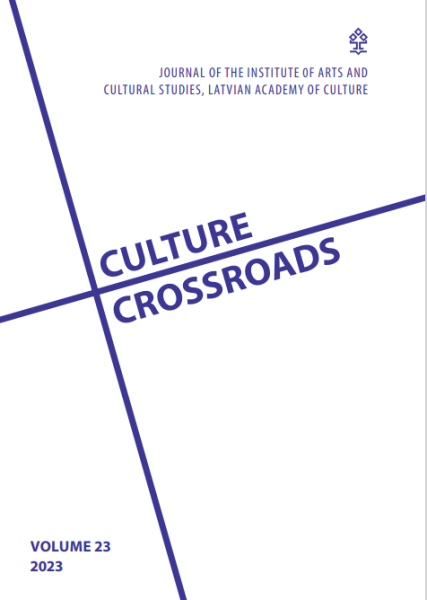OF STILL AND MOVING IMAGES: STYLISTICS OF HERCS FRANKS’ EARLY DOCUMENTARIES
DOI:
https://doi.org/10.55877/cc.vol23.377Keywords:
documentary cinema, intermediality, Hercs Franks, photography, televisionAbstract
Latvian documentary filmmaker Hercs Franks (1926–2013) directed his first films in 1965, the two short documentaries were produced at the Latvian television’s production unit Telefilma-Rīga: “Salty Bread” (Sāļā maize) and “At Noon” (Pusdienā). Both films reflect an intricate practice and aesthetic element of the director – the use of still photography, which for him is both a research tool and a stylistic device present throughout his career. “Salty Bread” includes photographs as a stylistic element allowing the viewer to prolong observation of particular images, whereas in “At Noon” still photographs feature on the films’ credits, but more significant is photography’s use as a research tool for preparing the film.
The intermedial studies have explored the interrelationship of different media and used intermediality as a tool for close reading of specific works, among other applications. The connection of cinema and photography represent the potential of intermedial approach through the technological, aesthetic, institutional practices. Specifically documentary cinema in its relation to photography shares additional issues of the meaning of documentality and representation of reality.
Through close reading of Hercs Franks’ first films, I would argue that Franks transcends normative documentary function in the use of still photographs [Hallas 2023] and demonstrates the intermedial practice in combining photography and documentary filmmaking.
Downloads
References
Azoulay, A. (2012). The Civil Imagination: A Political Ontology of Photography. London, New York: Verso.
Beckman, K., Ma, J. (2008). Introduction. In K. Beckman, J. Ma (eds.). Still Moving. Between Cinema and Photography. Durham, London: Duke University Press.
Campany, D. (2008). Photography and Cinema. London: Reaktion books.
Franks, H. (2011). Uz sliekšņa atskaties. Rīga: Mansards.
Friday, J. (2006). Stillness Becoming: Reflections on Bazin, Barthes and Photographic Stillness. In D. Green, J. Lowry (eds.), Stillness and Time: Photography and the Moving Image. Brighton: Photoworks/ Photoforum.
Guido, L. (2012). Introduction: The Paradoxical Fits and Starts of the New “Optical Unconscious”. In G. Laurent, O. Lugon (eds.), Between Still and Moving Images. Barnet: John Libbey Publishing.
Hallas, R. (2023). A Medium Seen Otherwise. Photography in Documentary Film. New York: Oxford University Press.
Kainaizis, V. (1974). Cieņa darbam un darba cilvēkam. Karogs. Nr. 8, 1974.
Kalniņš, R. (1966). Telekinodokumentālisti. Māksla, Nr. 3 (01.07.1966.).
Nichols, B. (1991). Representing Reality: Issues in Documentary Representation. Bloomington: Indiana Univeristy Press.
Paech, J. (2011). The Intermediality of Film. Acta Universitatis Sapientiae Film and Media Studies, Vol. 4, pp. 7–21.
Pethő, Á. (2010). Intermediality in Film: A Historiography of Methodologies. Acta Universitatis Sapientiae Film and Media Studies, Vol. 2, pp. 39–72.
Pērkone, I. (2013). Tu, lielā vakara saule! Esejas par modernismu Latvijas filmās. Rīga: Neputns.
Rikards, R. (2009). Mūža atspulgi TV. Rīga: Studija “Scilla”.
Stewart, G. (1999). Between Film and Screen: Modernism’s Photo Synthesis. Chicago: University of Chicago Press.
Downloads
Published
Issue
Section
License
Copyright (c) 2023 Culture Crossroads

This work is licensed under a Creative Commons Attribution 4.0 International License.


